engine MITSUBISHI ASX 2015 (in English) Owners Manual
[x] Cancel search | Manufacturer: MITSUBISHI, Model Year: 2015, Model line: ASX, Model: MITSUBISHI ASX 2015Pages: 452, PDF Size: 20.1 MB
Page 217 of 452
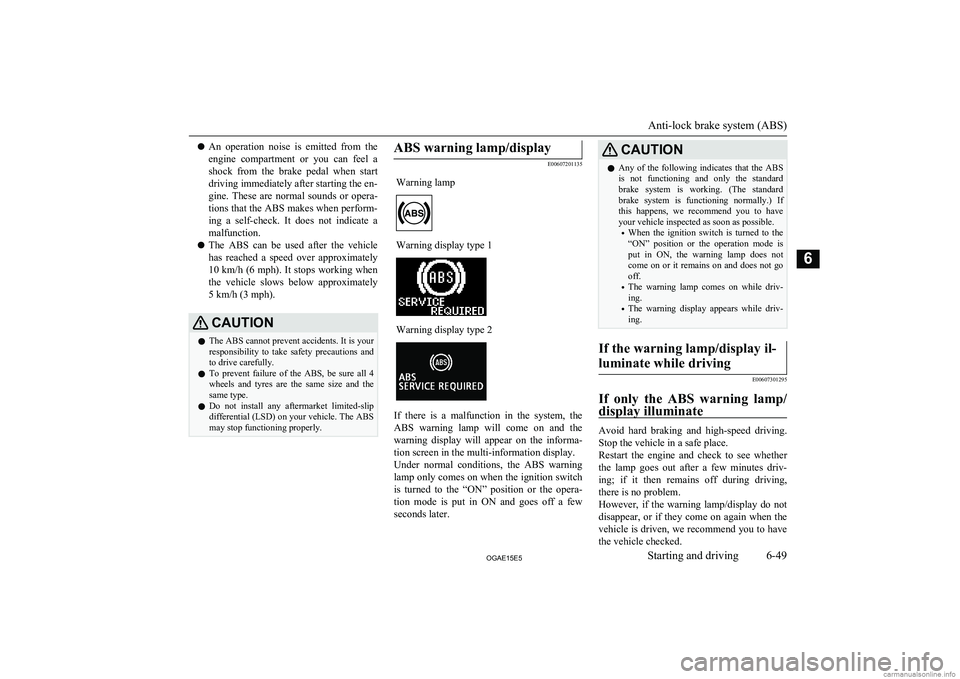
lAn operation noise is emitted from the
engine compartment or you can feel a shock from the brake pedal when start
driving immediately after starting the en-
gine. These are normal sounds or opera- tions that the ABS makes when perform-ing a self-check. It does not indicate a
malfunction.
l The ABS can be used after the vehicle
has reached a speed over approximately 10 km/h (6 mph). It stops working when the vehicle slows below approximately5 km/h (3 mph).CAUTIONl The ABS cannot prevent accidents. It is your
responsibility to take safety precautions and to drive carefully.
l To prevent failure of the ABS, be sure all 4
wheels and tyres are the same size and the same type.
l Do not install any aftermarket limited-slip
differential (LSD) on your vehicle. The ABS may stop functioning properly.ABS warning lamp/display
E00607201135
Warning lampWarning display type 1Warning display type 2
If there is a malfunction in the system, the
ABS warning lamp will come on and the
warning display will appear on the informa- tion screen in the multi-information display.
Under normal conditions, the ABS warning
lamp only comes on when the ignition switch
is turned to the “ON” position or the opera- tion mode is put in ON and goes off a few
seconds later.
CAUTIONl Any of the following indicates that the ABS
is not functioning and only the standard brake system is working. (The standardbrake system is functioning normally.) If
this happens, we recommend you to have
your vehicle inspected as soon as possible.
• When the ignition switch is turned to the
“ON” position or the operation mode is put in ON, the warning lamp does notcome on or it remains on and does not go
off.
• The warning lamp comes on while driv-
ing.
• The warning display appears while driv-
ing.If the warning lamp/display il-
luminate while driving
E00607301295
If only the ABS warning lamp/ display illuminate
Avoid hard braking and high-speed driving.
Stop the vehicle in a safe place.
Restart the engine and check to see whether the lamp goes out after a few minutes driv-
ing; if it then remains off during driving,
there is no problem.
However, if the warning lamp/display do not disappear, or if they come on again when the
vehicle is driven, we recommend you to have the vehicle checked.
Anti-lock brake system (ABS)
6-49OGAE15E5Starting and driving6
Page 218 of 452
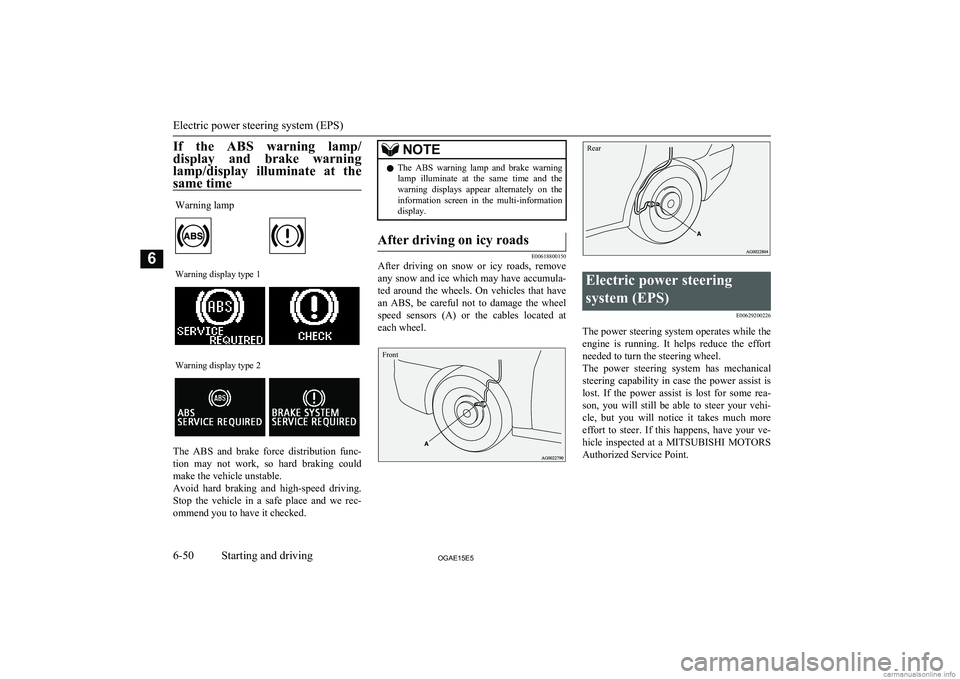
If the ABS warning lamp/display and brake warning
lamp/display illuminate at the same timeWarning lampWarning display type 1Warning display type 2
The ABS and brake force distribution func- tion may not work, so hard braking could
make the vehicle unstable.
Avoid hard braking and high-speed driving.
Stop the vehicle in a safe place and we rec-
ommend you to have it checked.
NOTEl The ABS warning lamp and brake warning
lamp illuminate at the same time and the
warning displays appear alternately on the information screen in the multi-informationdisplay.After driving on icy roads
E00618800150
After driving on snow or icy roads, remove
any snow and ice which may have accumula-
ted around the wheels. On vehicles that have
an ABS, be careful not to damage the wheel
speed sensors (A) or the cables located at each wheel.
FrontRear
Electric power steering
system (EPS) E00629200226
The power steering system operates while theengine is running. It helps reduce the effort
needed to turn the steering wheel.
The power steering system has mechanical
steering capability in case the power assist is lost. If the power assist is lost for some rea-
son, you will still be able to steer your vehi-
cle, but you will notice it takes much more effort to steer. If this happens, have your ve-hicle inspected at a MITSUBISHI MOTORS
Authorized Service Point.
Electric power steering system (EPS)
6-50OGAE15E5Starting and driving6
Page 219 of 452

WARNINGlDo not stop the engine while the vehicle is
moving. Stopping the engine would make the steering wheel extremely hard to turn,
possibly resulting in an accident.NOTEl During repeated full-lock turning of the
steering wheel (for example, while you are manoeuvring the vehicle into a parking space), a protection function may be activa-
ted to prevent overheating of the power steering system. This function will make the
steering wheel gradually harder to turn. In
this event, limit your turning of the steering wheel for a while. When the system has
cooled down, the steering action will return to normal.
l If you turn the steering wheel while the vehi-
cle is stationary with the headlamps on, the
headlamps may become dim. This behaviour is not abnormal. The headlamps will returnto their original brightness after a shortwhile.Electric power steering system
warning displayType 1Type 2
When there is a malfunction in the system, the warning display will appear on the infor-
mation screen in the multi-information dis-
play.
CAUTIONl If the warning display appears while engine
is running, have the vehicle inspected by a
MITSUBISHI MOTORS Authorized Serv-
ice Point as soon as possible. It may become
harder to turn the steering wheel.Active stability control
(ASC)* E00616700331
The Active Stability Control (ASC) takes
overall control of the anti-lock brake system, traction control function and stability control
function to help maintain the vehicle’s con-
trol and traction. Please read this section in conjunction with the page on the anti-lock
brake system, traction control function and stability control function.
Anti-lock brake system (ABS) ® p. 6-48
Traction control function ® p. 6-52
Stability control function ® p. 6-52CAUTIONl Do not over-rely on the ASC. Even the ASC
cannot prevent the natural laws of physics
from acting on the vehicle.
This system, like any other system, has lim-
its and cannot help you to maintain traction and control of the vehicle in all circumstan- ces. Reckless driving may lead to accidents. It is the driver’s responsibility to drive care-
fully. This means taking into account the traffic, road and environmental conditions.
l Be sure to use the same specified type and
size of tyre on all 4 wheels. Otherwise, the ASC may not work properly.
Active stability control (ASC)*
6-51OGAE15E5Starting and driving6
Page 220 of 452

CAUTIONlDo not install any aftermarket limited-slip
differential (LSD) on your vehicle. The ASC
may stop functioning properly.NOTEl An operation noise may be emitted from the
engine compartment in the following situa-
tions. The sound is associated with checking the operations of the ASC. At this time, you
may feel a shock from the brake pedal if you depress it. These do not indicate a malfunc-
tion.
• When the ignition switch is turned to the
“ON” position or the operation mode is
put in ON.
• When the vehicle is driven for a while af-
ter the engine is turned on.
l When the ASC is activated, you may feel a
vibration in the vehicle body or hear a whin- ing sound from the engine compartment.
This indicates that the system is operating
normally. It does not indicate a malfunction.
l When the anti-lock brake system warning
lamp is illuminated, the ASC is not active.Traction control function
E00619000087
On slippery surfaces, the traction control
function prevents the drive wheels from spin-
ning excessive, thus helping the vehicle to start moving from a stopped condition. It also
provides sufficient driving force and steering performance as the vehicle turns while press-
ing the acceleration pedal.
CAUTIONl When driving a vehicle on a snowy or icy
road, be sure to install snow tyres and drive
the vehicle at moderate speeds.Stability control function
E00619100017
The stability control function is designed to
help the driver maintain control of the vehicle
on slippery roads or during rapid steering ma-
noeuvres. It works by controlling the engine output and brake on each wheel.
NOTEl The stability control function operates at
speeds of about 15 km/h (9 mph) or higher.“ASC OFF” switch
E00619200353
The ASC is automatically activated when the
ignition switch is turned to the “ON” position or the operation mode is put in ON. You candeactivate the system by pressing down the
“ASC OFF” switch for 3 seconds or longer.
When the ASC is deactivated, the
display/
indicator will turn on. To reactivate the ASC, momentarily press the “ASC OFF” switch;
the
display/indicator is turned off.
CAUTIONl For safety reasons, the “ASC OFF” switch
should be operated when your vehicle is stopped.
l Be sure to keep the ASC on while driving in
normal circumstances.
Active stability control (ASC)*
6-52OGAE15E5Starting and driving6
Page 221 of 452
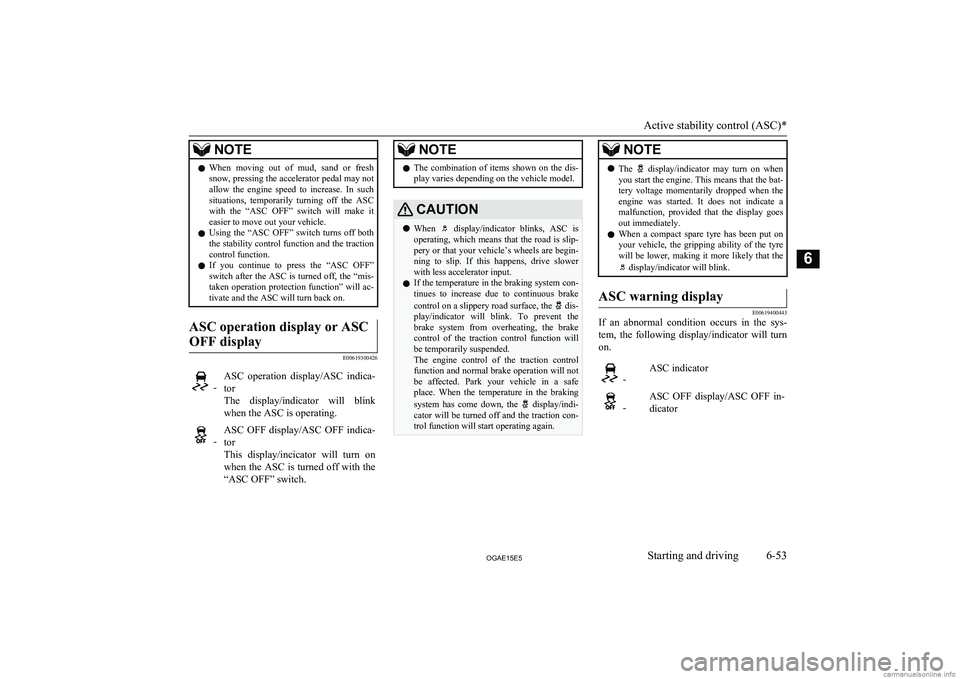
NOTElWhen moving out of mud, sand or fresh
snow, pressing the accelerator pedal may not
allow the engine speed to increase. In such
situations, temporarily turning off the ASC with the “ASC OFF” switch will make it
easier to move out your vehicle.
l Using the “ASC OFF” switch turns off both
the stability control function and the traction control function.
l If you continue to press the “ASC OFF”
switch after the ASC is turned off, the “mis-
taken operation protection function” will ac- tivate and the ASC will turn back on.ASC operation display or ASC
OFF display
E00619300426
-ASC operation display/ASC indica- tor
The display/indicator will blink when the ASC is operating. -ASC OFF display/ASC OFF indica-
tor
This display/incicator will turn on when the ASC is turned off with the “ASC OFF” switch.NOTEl The combination of items shown on the dis-
play varies depending on the vehicle model.CAUTIONl When display/indicator blinks, ASC is
operating, which means that the road is slip- pery or that your vehicle’s wheels are begin-
ning to slip. If this happens, drive slower with less accelerator input.
l If the temperature in the braking system con-
tinues to increase due to continuous brake
control on a slippery road surface, the
dis-
play/indicator will blink. To prevent the
brake system from overheating, the brake
control of the traction control function will
be temporarily suspended.
The engine control of the traction control
function and normal brake operation will not be affected. Park your vehicle in a safeplace. When the temperature in the braking
system has come down, the
display/indi-
cator will be turned off and the traction con- trol function will start operating again.
NOTEl The display/indicator may turn on when
you start the engine. This means that the bat- tery voltage momentarily dropped when the
engine was started. It does not indicate a malfunction, provided that the display goes out immediately.
l When a compact spare tyre has been put on
your vehicle, the gripping ability of the tyre
will be lower, making it more likely that the
display/indicator will blink.
ASC warning display
E00619400443
If an abnormal condition occurs in the sys-
tem, the following display/indicator will turn
on.
-ASC indicator -ASC OFF display/ASC OFF in-
dicator
Active stability control (ASC)*
6-53OGAE15E5Starting and driving6
Page 222 of 452
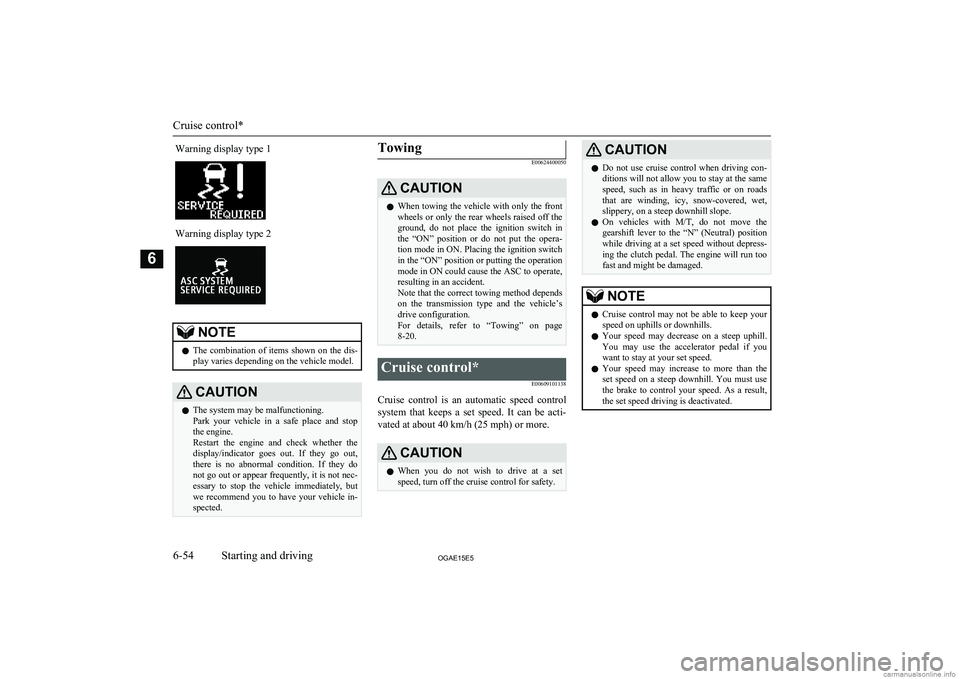
Warning display type 1Warning display type 2NOTElThe combination of items shown on the dis-
play varies depending on the vehicle model.CAUTIONl The system may be malfunctioning.
Park your vehicle in a safe place and stop
the engine.
Restart the engine and check whether the display/indicator goes out. If they go out,
there is no abnormal condition. If they do not go out or appear frequently, it is not nec- essary to stop the vehicle immediately, but
we recommend you to have your vehicle in- spected.Towing
E00624400050CAUTIONl When towing the vehicle with only the front
wheels or only the rear wheels raised off the
ground, do not place the ignition switch in the “ON” position or do not put the opera- tion mode in ON. Placing the ignition switchin the “ON” position or putting the operation
mode in ON could cause the ASC to operate, resulting in an accident.
Note that the correct towing method depends
on the transmission type and the vehicle’s drive configuration.
For details, refer to “Towing” on page 8-20.Cruise control*
E00609101138
Cruise control is an automatic speed controlsystem that keeps a set speed. It can be acti-vated at about 40 km/h (25 mph) or more.
CAUTIONl When you do not wish to drive at a set
speed, turn off the cruise control for safety.CAUTIONl Do not use cruise control when driving con-
ditions will not allow you to stay at the same speed, such as in heavy traffic or on roads
that are winding, icy, snow-covered, wet, slippery, on a steep downhill slope.
l On vehicles with
M/T, do not move the
gearshift lever to the “N” (Neutral) position
while driving at a set speed without depress- ing the clutch pedal. The engine will run too
fast and might be damaged.NOTEl Cruise control may not be able to keep your
speed on uphills or downhills.
l Your speed may decrease on a steep uphill.
You may use the accelerator pedal if you
want to stay at your set speed.
l Your speed may increase to more than the
set speed on a steep downhill. You must use the brake to control your speed. As a result, the set speed driving is deactivated.
Cruise control*
6-54OGAE15E5Starting and driving6
Page 223 of 452
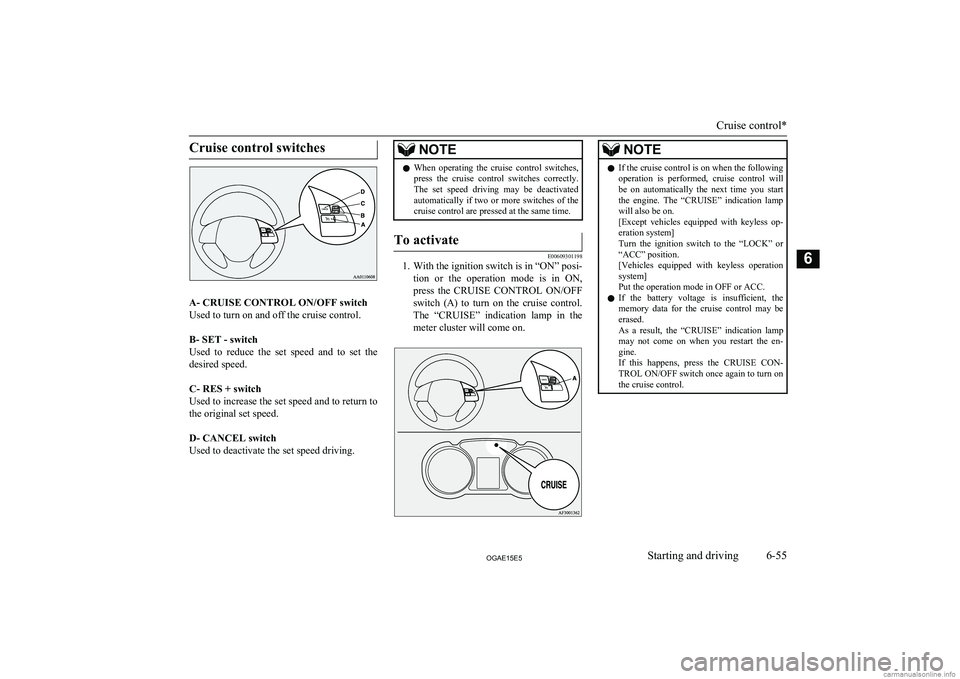
Cruise control switches
A- CRUISE CONTROL ON/OFF switchUsed to turn on and off the cruise control.
B- SET - switch
Used to reduce the set speed and to set the
desired speed.
C- RES + switch
Used to increase the set speed and to return to
the original set speed.
D- CANCEL switch
Used to deactivate the set speed driving.
NOTEl When operating the cruise control switches,
press the cruise control switches correctly.
The set speed driving may be deactivated automatically if two or more switches of the
cruise control are pressed at the same time.To activate
E00609301198
1. With the ignition switch is in “ON” posi-
tion or the operation mode is in ON,press the CRUISE CONTROL ON/OFF
switch (A) to turn on the cruise control. The “CRUISE” indication lamp in the meter cluster will come on.
NOTEl If the cruise control is on when the following
operation is performed, cruise control will be on automatically the next time you start the engine. The “CRUISE” indication lamp
will also be on.
[Except vehicles equipped with keyless op- eration system]
Turn the ignition switch to the “LOCK” or
“ACC” position.
[Vehicles equipped with keyless operation
system]
Put the operation mode in OFF or ACC.
l If the battery voltage is insufficient, the
memory data for the cruise control may be
erased.
As a result, the “CRUISE” indication lamp may not come on when you restart the en-
gine.
If this happens, press the CRUISE CON-
TROL ON/OFF switch once again to turn on
the cruise control.
Cruise control*
6-55OGAE15E5Starting and driving6
Page 226 of 452
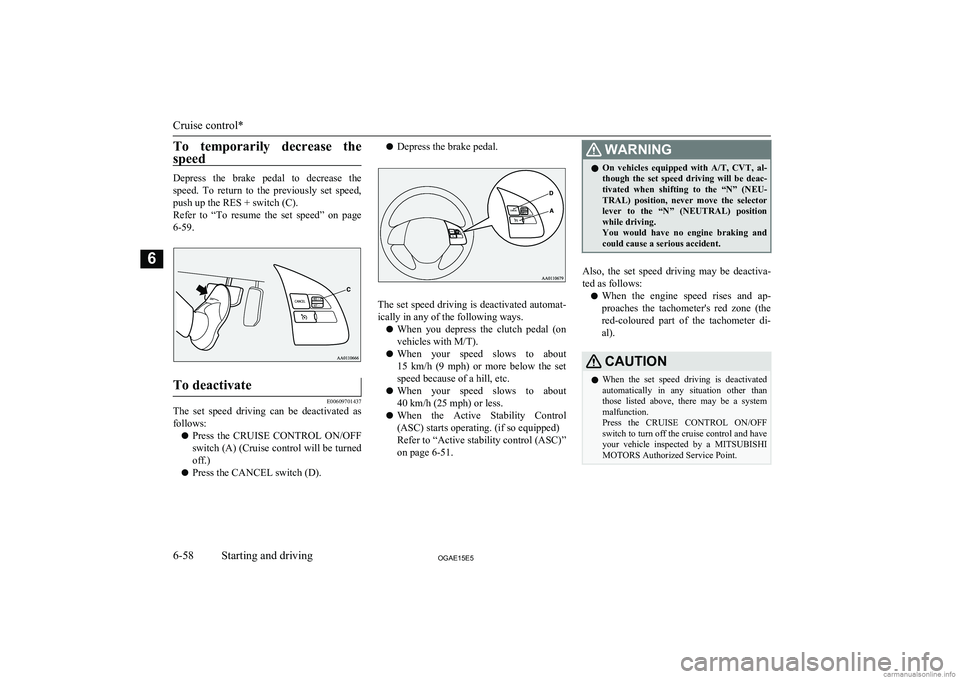
To temporarily decrease the
speed
Depress the brake pedal to decrease the speed. To return to the previously set speed,
push up the RES + switch (C).
Refer to “To resume the set speed” on page
6-59.
To deactivate
E00609701437
The set speed driving can be deactivated as follows:
l Press the CRUISE CONTROL ON/OFF
switch (A) (Cruise control will be turned off.)
l Press the CANCEL switch (D).
l Depress the brake pedal.
The set speed driving is deactivated automat-
ically in any of the following ways.
l When you depress the clutch pedal (on
vehicles with M/T).
l When your speed slows to about
15 km/h (9 mph) or more below the set
speed because of a hill, etc.
l When your speed slows to about
40 km/h (25 mph) or less.
l When the Active Stability Control
(ASC) starts operating. (if so equipped)
Refer to “Active stability control (ASC)”
on page 6-51.
WARNINGl On vehicles equipped with
A/T, CVT, al-
though the set speed driving will be deac-
tivated when shifting to the “N” (NEU-
TRAL) position, never move the selector lever to the “N” (NEUTRAL) position
while driving.
You would have no engine braking and
could cause a serious accident.
Also, the set speed driving may be deactiva-
ted as follows:
l When the engine speed rises and ap-
proaches the tachometer's red zone (the red-coloured part of the tachometer di- al).
CAUTIONl When the set speed driving is deactivated
automatically in any situation other than those listed above, there may be a systemmalfunction.
Press the CRUISE CONTROL ON/OFF switch to turn off the cruise control and have your vehicle inspected by a MITSUBISHI
MOTORS Authorized Service Point.
Cruise control*
6-58OGAE15E5Starting and driving6
Page 229 of 452

CAUTIONlIf a malfunction is detected in the tyre pres-
sure monitoring system (TPMS), the warn- ing lamp will blink for approximately 1 mi-
nute and then remain continuously illumina-
ted.
The warning lamp will issue further warn- ings each time the engine is restarted as long
as the malfunction exists.
Check to see whether the warning lamp goes
off after few minutes driving.
If it then goes off during driving, there is no
problem.
However, if the warning lamp does not go off, or if it blinks again when the engine is
restarted, have the vehicle inspected by a MITSUBISHI MOTORS Authorized Serv-
ice Point.
In such situations, a malfunctioning of the system may be preventing the monitoring of the tyre pressure. For safety reasons, when
the warning lamp appears while driving,
avoid sudden braking, sharp turning and high-speed driving.NOTEl In addition, the warning display will be dis-
played on the information screen in the mul-
ti-information display.NOTEType 1Type 2
Each tyre, including the spare (if so equip-
ped), should be checked monthly when cold and inflated to the inflation pressure recom-
mended by the vehicle manufacturer on the tyre inflation pressure label. (If your vehiclehas tyres of a different size than the size indi-
cated on the tyre inflation pressure label, you
should determine the proper tyre inflationpressure for those tyres.)
As an added safety feature, your vehicle has
been equipped with the tyre pressure moni- toring system (TPMS) that illuminates a low
tyre pressure telltale when one or more of
your tyres is significantly under-inflated.
Accordingly, when the low tyre pressure tell-
tale illuminates, you should stop and checkyour tyres as soon as possible, and inflate
them to the proper pressure. Driving on a sig- nificantly under-inflated tyre causes the tyre
to overheat and can lead to tyre failure.
Under-inflation also reduces fuel efficiency and tyre tread life, and may affect the vehi-
cle’s handling and stopping ability.
Please note that the tyre pressure monitoring system (TPMS) is not a substitute for proper
tyre maintenance, and it is the driver’s re- sponsibility to maintain correct tyre pressure,
even if under-inflation has not reached thelevel to trigger illumination of the tyre pres-
sure monitoring system (TPMS) low tyre
pressure telltale.
Your vehicle has also been equipped with a warning lamp to indicate when the system is
not operating properly.
The warning lamp is combined with the low
tyre pressure telltale.
When the system detects a malfunction, the
telltale will flash for approximately one mi- nute and then remain continuously illumina- ted. This sequence will continue upon subse-
quent vehicle start-ups as long as the mal-
function exists.
When the warning lamp is illuminated, the system may not be able to detect or signal
low tyre pressure as intended.
Tyre pressure monitoring system (TPMS)*
6-61OGAE15E5Starting and driving6
Page 234 of 452

NOTElThe sensors do not detect objects located in
the area directly below or near the bumper. If the height of an object is lower than the
mounted position of the corner or back sen-
sors, the sensors may not continue detecting it even if they detected it initially.
For information on how to change the detec-
tion areas, please refer to “Changing the de- tection areas” on page 6-67.
CAUTIONl The reversing sensor system may not operate
properly under the following conditions:
• The sensors or surroundings are covered
with ice, snow, or mud.
• The sensors are frozen.
• The system receives ultrasonic noise from
other sources (the horns of other vehicles, motorcycle engines, brakes, radios, pour-
ing rain, splashing water, tyre chains, etc.).
• The sensors are extremely hot or cold
(while the vehicle is parked for a long pe- riod of time under a blazing sun or in coldweather).
• The vehicle tilts significantly.
• The vehicle is driven on a rough road
(with a bumpy, gravel, hilly, or grassy surface).
• The vehicle is too close to an obstacle.CAUTION•The sensors or surroundings have been
wiped by hand, or stickers or accessorieshave been attached.
l The reversing sensor system may not proper-
ly detect the following:
• Objects that are thin, such as wire nets or
ropes.
• Objects that absorb sound waves, such as
snow.
• Objects that are shaped with a sharp an-
gle.
• Objects with a smooth surface, such as
glass.
• Objects that are low, such as kerbstones.NOTEl The buzzer may sound lower than the nor-
mal warning sound when the reversing sen-sor system is receiving ultrasonic noise from
other sources, but this is not a malfunction.
The buzzer will stop sounding and the sys- tem will return to normal operation after thenoise is no longer received.To operate
E00615700738
To operate the system, move the gearshift
lever or selector lever to the “R” position while the ignition switch or the operationmode is in ON. When the reversing sensor
system is operated, the reversing sensor sys-
tem operation indication lamp (A) will turn on. To stop the operation, push the “SO-
NAR” switch; the reversing sensor system operation indication lamp (A) is turned off.
NOTEl Only when the gearshift lever or selector
lever is in the “R” position, the reversing
sensor system can be operated or be stopped by using the “SONAR” switch.
Reversing sensor system*
6-66OGAE15E5Starting and driving6